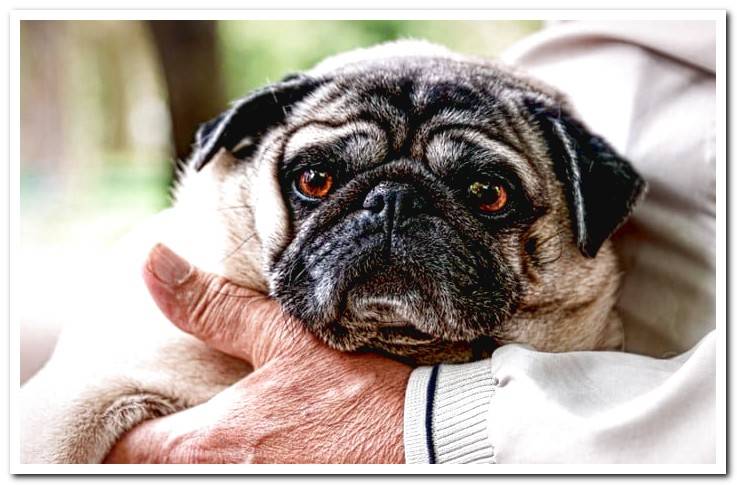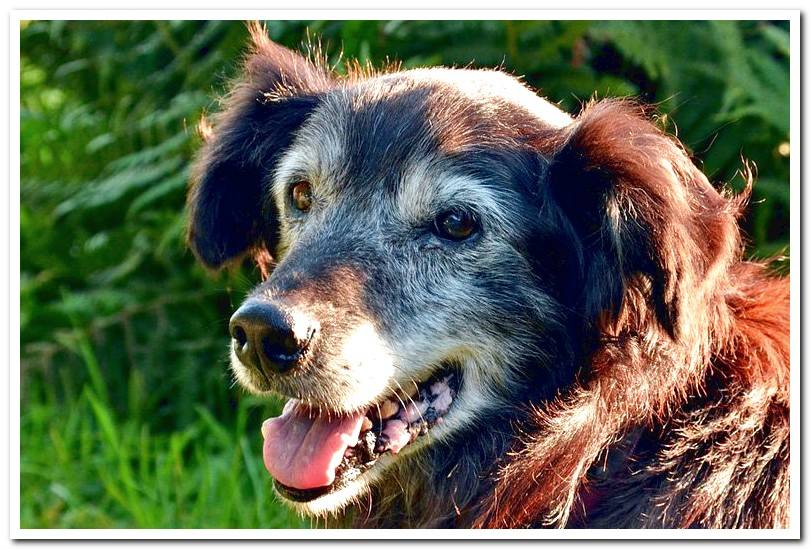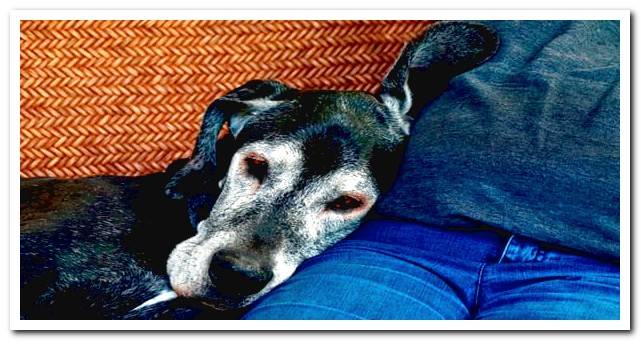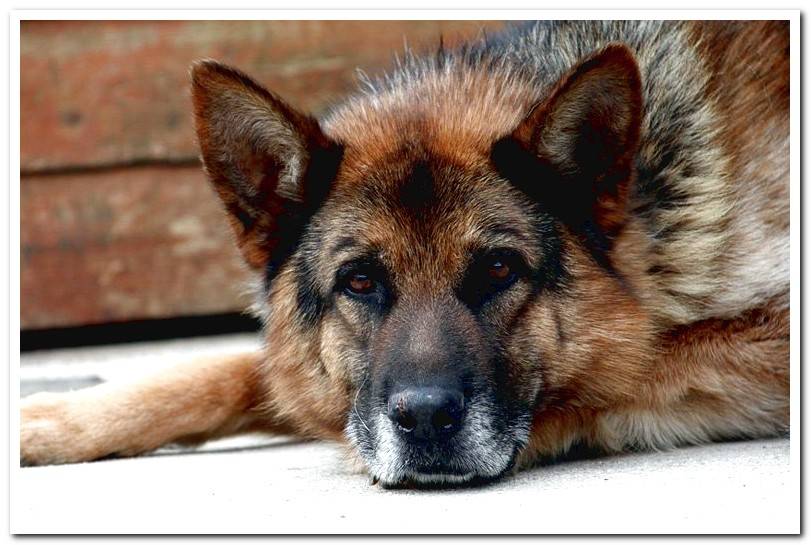
If your friend is already 7 years old, you may begin to notice certain changes in their behavior and appearance. You may urinate at home sometime, may not respond to your name, or feel more inactive; but calm down, it’s probably all due to age.
As with people, dogs experience certain behavioral and health disturbances as they reach middle age, not to mention obvious physical changes, such as gray hair or dental and skin problems.
Today, from Soy un Perro we want to present you those 10 signs of old age in dogs that indicate that our dog has grown older. However, although these signs may be due to age, they should not be neglected, so a visit to the vet will not hurt.
Index of contents
- 1 Physical signs of old age in dogs
- 1.1 1. Changes in skin and hair
- 1.2 2. Changes in eye color
- 1.3 3. Caries and tartar
- 2 Behavioral signs of old age in dogs
- 2.1 4. Tiredness and less desire to play
- 2.2 5. Stiffness and body aches
- 2.3 6. Decreased appetite and increased thirst
- 3 Health problems in elderly dogs
- 3.1 7. Loss of acuity of the senses
- 3.2 8. Urinary incontinence
- 3.3 9. Weight changes
- 3.4 10. Development of degenerative diseases and tumors
Physical signs of old age in dogs
1. Changes in skin and hair
It is normal that when our dogs begin to grow older, certain signs appear on the skin, such as corns, dryness and problems with their pads. At the same time, you will see that your friend appears white hair or colored spots on its coat.
2. Changes in eye color
Another physical change that dogs experience is the color of their eyes. It loses intensity over the years, giving it a grayish color. As in the rest of the cases, although it is due to age, the vet should be consulted to rule out or treat possible cataracts.
3. Caries and tartar
Although this feature is linked to breed and oral hygiene, it is common to see that dog teeth get worse over the years. Veterinary follow-up is recommended and clean dog’s teeth to avoid cavities and tartar and that it can feed without problems.

Behavioral signs of old age in dogs
4. Tiredness and less desire to play
Remember the puppy time when your dog’s energy seemed inexhaustible? Now the situation is completely opposite. Calm comes home with an elderly dog. It will be normal for you to observe that your dog walks slower and has less desire to play and walk.
Remember that, as with humans, dogs that reach old age they need tranquility and rest, so they should not be forced to exercise. Otherwise, you will harm the health of your joints and bones.
Of course, extra doses of pampering and attention will not hurt, as well as moderate exercise, always following your rhythm. In any case, a veterinary review will rule out that what happens to the dog is not a health problem.
One positive thing about your puppy being less active is that he will also become stable, calm and, above all, more affectionate. Elderly dogs tend to be more delicate and dedicate more time to the caresses and kisses of their masters.
5. Stiffness and body aches
Another sign of old age is stiffness and muscle aches. This may be due to diseases like arthritis or an inflammatory problem, so we must go to the vet regularly so that I can assess his health and give him medication if he considers it necessary.
6. Decreased appetite and increased thirst
Changes in appetite and increased thirst may be linked to any of the problems mentioned in this article, such as muscle pain, decreased exercise, tooth decay, or a possible symptom of a disease, such as infections or renal insufficiency.
Therefore, once again it is convenient to visit the vet to know the origin of this change, although it may only be due to a behavioral sign of old age. Your dog may need medication, vitamin supplements, or motivation to eat.

Health problems in elderly dogs
7. Loss of acuity of the senses
Eyesight, smell and hearing lose some acuity in dogs that reach old age. For example, cataracts, blindness, and deafness are typical problems in these dogs Therefore, a veterinary follow-up will also be very important in these cases.
In addition, you should find new ways to communicate with your puppy according to the problem that occurs. Avoid disorientation and don’t move your belongings around. Also, pay more attention and love so that you feel calm and comfortable inside and outside the home.
8. Urinary incontinence
Coupled with the sign of increased thirst, the dog will feel more need to urinate, which is difficult for some older dogs to control. In some cases this urinary incontinence is due to hormonal problems or possible failure of some organs.
Go to the vet to rule out serious problems and be patient and understanding. The inability to control urination can make your puppy feel very bad if you get angry. Clean his urine better when he does not see you so as not to frustrate him and choose to give him more walks.
9. Weight changes
It is common for older dogs to undergo weight changes. However, we should not ignore this since it is essential to maintain your friend’s weight as the vet tells you, as well as follow an age-appropriate diet (senior food or +7).
Obesity, drastic weight loss, or loss or increase of appetite may indicate health complications, like hormonal problems; or even carry them, such as joint and bone problems. Find out how you can avoid obesity in dogs.
10. Development of degenerative diseases and tumors
As your dog gets older, it will have more possibilities of developing degenerative diseases, such as osteoarthritis, dys
plasias, osteoarthritis, and also neurodegenerative diseases, such as Alzheimer’s.
Along with these problems it is normal that we observe symptoms such as sadness, discomfort and pain. Strange behaviors may also occur, such as dogs with Alzheimer’s They may forget where their bed or food is.
To help you, we only have to go to the appropriate veterinary reviews to help you control physical symptoms and offer you a lot of love and attention from us. Supervision at this stage is essential to guarantee your well-being.

On the other hand, tumors become more common in dogs with advanced age. As soon as you detect a lump you should go to the vet. The sooner the better. There, the specialist will indicate if it is a benign or malignant tumor and the treatment and care to follow.
Your dog, like you, will probably notice the physical and mental changes it is undergoing. This can lead to decline and increased dependency, so you should offer guidance and support to ensure their comfort.
If you want to know more tips to adapt to the needs of your dog, visit the guide how to care for an elderly dog. And remember, that your dog has grown older is not something that should make us sad, on the contrary, it values the quality of life it has had and still has.
